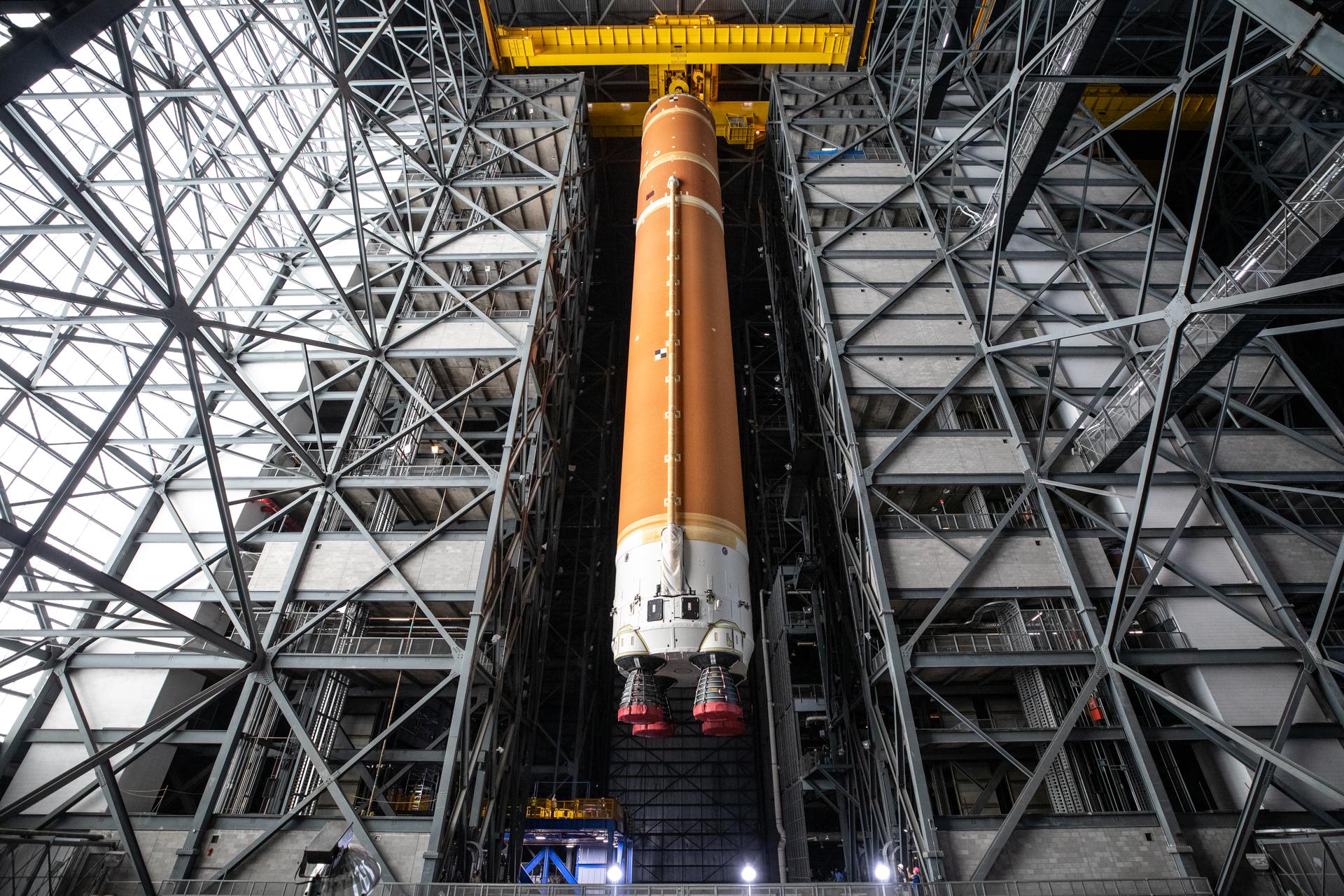

NASA has taken a big step forward in how engineers will assemble and stack future SLS (Space Launch System) rockets for Artemis Moon missions inside the Vehicle Assembly Building (VAB) at the agency’s Kennedy Space Center in Florida.
The VAB’s High Bay 2 has been outfitted with new tooling to facilitate the vertical integration of the SLS core stage. That progress was on full display in mid-December when teams suspended the fully assembled core stage 225 feet in the air inside the high bay to complete vertical work before it is stacked on mobile launcher 1, allowing teams to continue solid rocket booster stacking simultaneously inside High Bay 3 for Artemis II.

With the move to High Bay 2, technicians with NASA and Boeing now have 360-degree tip to tail access to the core stage, both internally and externally. Michigan-based supplier Futuramic Tool and Engineering led the design and build of the Core Stage Vertical Integration Center tool that will hold the core stage in a vertical position.
“High Bay 2 tooling was originally scheduled to be complete for Artemis III. We had an opportunity to get it done earlier and that will put us in a good posture to complete work earlier than planned prior to moving the core stage for Artemis II into the full integrated stack over into in High Bay 3,” said Chad Bryant, deputy manager of the NASA SLS Stages Office. “This gives us an opportunity to go in and learn how to rotate, lift, and move the core stage into the high bay.”
This move also doubles the footprint of useable space within the VAB, giving engineers access to both High Bay 2 and High Bay 3 simultaneously, while also freeing up space at NASA’s Michoud Assembly Facility in New Orleans to continue work on the individual elements for future SLS core stages.
High Bay 2 has a long history of supporting NASA exploration programs: during Apollo, High Bay 2, one of four high bays inside the VAB, was used to stack the Saturn V rocket. During the Space Shuttle Program, the high bay was used for external tank checkout and storage and as an extra storage area for the shuttle.
Under the new assembly model beginning with Artemis III, all the major structures for the SLS core stage will continue to be fully produced and manufactured at NASA Michoud. Upon completion of manufacturing and thermal protection system application, the engine section will be shipped to Kennedy for final outfitting.
“Core stage 3 marks a significant change in the way we build core stages,” said Steve Wofford, manager of the SLS Stages Office. “The vertical capability in High Bay 2 allows us to perform parallel processing from the top to bottom of the stage. It’s a much more efficient way to build core stages. This new capability will streamline final production efforts, allowing our team to have 360-degree access to the stage, both internally and externally.”
The fully assembled core stage for Artemis II arrived July 23, 2024, at Kennedy, where it remained horizontal inside the VAB transfer aisle until its recent lift into the newly outfitted high bay.
Teams at NASA Michoud are outfitting the remaining core stage elements for Artemis III and preparing to horizontally join them. The four RS-25 engines for the Artemis III mission are complete at NASA’s Stennis Space Center in Bay St. Louis, Mississippi, and will be transported to NASA Kennedy in 2025. Major core stage and exploration upper stage structures are in work at NASA Michoud for Artemis IV and beyond.
NASA is working to land the first woman, first person of color, and its first international partner astronaut on the Moon under Artemis. SLS is part of NASA’s backbone for deep space exploration, along with the Orion spacecraft, supporting ground systems, advanced spacesuits and rovers, the Gateway in orbit around the Moon, and commercial human landing systems. SLS is the only rocket that can send Orion, astronauts, and supplies to the Moon in a single launch.
News Media Contact
Jonathan Deal
Marshall Space Flight Center
Huntsville, Ala.
256-544-0034